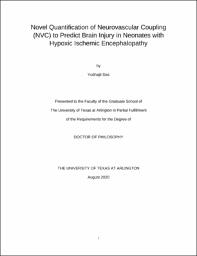
ATTENTION: The works hosted here are being migrated to a new repository that will consolidate resources, improve discoverability, and better show UTA's research impact on the global community. We will update authors as the migration progresses. Please see MavMatrix for more information.
Show simple item record
| dc.creator | Das, Yudhajit | |
| dc.date.accessioned | 2020-09-10T14:00:08Z | |
| dc.date.available | 2020-09-10T14:00:08Z | |
| dc.date.created | 2020-08 | |
| dc.date.issued | 2020-09-04 | |
| dc.date.submitted | August 2020 | |
| dc.identifier.uri | http://hdl.handle.net/10106/29374 | |
| dc.description.abstract | Birth asphyxia is a global burden in clinical neonatal care. It results from deprivation of oxygen to a newborn infant that lasts too long during the birth causing physical harm to the brain. The asphyxia insult impairs fetal cerebral blood flow and results in a distinctive neonatal encephalopathy (NE). Hypoxic-ischemic encephalopathy (HIE) accounts for a significant proportion of encephalopathic newborns. Currently there is no reliable quantitative metric is available to predict outcome of neurological injury in neonates with HIE at the bedside in the first day of life. My dissertation targets on this gap by developing novel quantification methods of neurovascular coupling (NVC) that can be used to predict brain abnormalities in HIE neonates.
First of all, amplitude-integrated encephalogram (aEEG) and near-infrared spectroscopy (NIRS-SctO2) are conventional tools used by the clinicians at the bedside for continuous monitoring of hemodynamics, cerebral perfusion and cerebral function of these asphyxiated neonates. But since no standardized algorithm exists for quantifying aEEG signal from raw EEG, numerous aEEG devices are flooding the market everyday with their multitude differences in aEEG output. This represents a significant challenge for the rigor of aEEG-dependent clinical analysis. To address this gap, we examined whether variabilities in the aEEG outputs derived from various methods impact the determination of NVC measured using aEEG and NIRS. The findings of this study confirm the robustness of NVC wavelet analysis in neonatal encephalopathy.
Next, the novel neurovascular wavelet transform coherence (WTC) methodology was applied as a physiological biomarker to predict the presence of brain injuries in neonates as early as the very first day of life. Based on brain magnetic resonance imaging (MRI) assessments, considered as a proxy of neurodevelopmental outcome, the entire cohort was grouped into two categories, with and without the evidence of neurological injury. WTC analysis was performed to quantify NVC for a duration of twenty hours in the first day of life; wavelet metrics of percentage significant SctO2-aEEG coherence were compared between the normal and abnormal MRI groups. The findings are significant and indicate that NVC-derived metrics measured in the first of life can be used as a physiological biomarker to accurately predict brain injury seen a few days later by MRI.
Dynamic activities of the human brain share both linear and non-linear relationship between neuronal electrophysiology and brain hemodynamics, namely NVC. While linear measures like WTC can determine spontaneous relation between aEEG and NIRS, they cannot detect the non-linear mechanisms affecting NVC. To the best of my knowledge, no study has utilized non-linear signal processing techniques to study non-linear mechanism. The final aim of my dissertation has explored dynamic time warping (DTW) as a non-linear method to understand the relation between neuronal activity and brain hemodynamics in neonates with HIE and evaluated the predictive ability of DTW for identifying neonates with neurological injury in the first day of life. | |
| dc.format.mimetype | application/pdf | |
| dc.language.iso | en_US | |
| dc.subject | Neurovascular coupling | |
| dc.subject | HIE | |
| dc.subject | Birth asphyxia | |
| dc.subject | Wavelet transform coherence | |
| dc.subject | aEEG | |
| dc.subject | fNIRS | |
| dc.title | Novel Quantification of Neurovascular Coupling (NVC) to Predict Brain Injury in Neonates with Hypoxic Ischemic Encephalopathy | |
| dc.type | Thesis | |
| dc.degree.department | Bioengineering | |
| dc.degree.name | Doctor of Philosophy in Biomedical Engineering | |
| dc.date.updated | 2020-09-10T14:00:09Z | |
| thesis.degree.department | Bioengineering | |
| thesis.degree.grantor | The University of Texas at Arlington | |
| thesis.degree.level | Doctoral | |
| thesis.degree.name | Doctor of Philosophy in Biomedical Engineering | |
| dc.type.material | text | |
| dc.creator.orcid | 0000-0001-6952-6199 | |
Files in this item
- Name:
- DAS-DISSERTATION-2020.pdf
- Size:
- 5.601Mb
- Format:
- PDF
This item appears in the following Collection(s)
Show simple item record


